High-Resolution Subsurface Characterization Using Seismic Inversion—Methodology and Examples
Abstract
1. Introduction
2. Amplitude-Variation-with-Angle (AVA) Inversion and Its Limitations
- The high velocities above 1.05 with a positive gradient in the 0.3–0.7 s window cause the rays to bend like the black and green ray paths in layers 1 and 2. So, the rays bend successively away from the normal and eventually reach the turning point for large angles.
- The low-velocity zone of the 1.05–1.6 s time window is analogous to layer 3 in Figure 2 and behaves like the blue ray path shown in this figure. So, the rays within this zone turn in the reverse direction and cause the offsets needed for -to- mapping to be very high. This effect is especially evident in the angle mute, as shown in Figure 6c. From these angle mutes (Figure 6a–c), the offsets needed for -to- mapping for these zone appear to be present in the data. However, because the rays needed for -to- mapping for within this zone reach the turning point due to the high velocities above 1.05 s, -to- mapping for these high angles in this zone is not possible, and, therefore, the reflection amplitudes for these high angles within this zone are anomalously low. This effect is also evident from the low reflection amplitudes in the angle mute for the 1.05–1.6 s time window (Figure 6c).
- The ray paths in high velocities below 1.6 s behave like those in layer 4, shown by the purple ray path in Figure 2. Because the angle mutes move in the reverse direction (see Figure 6a–c), the rays needed for -to- mapping for in this zone do not reach the turning point caused by the high-velocity layers above 1.05 s, and, consequently, the reflections for these high angles are visible.
3. Prestack Waveform Inversion with Genetic Algorithm Optimization
4. Inversion Setup
5. AVA Inversion
6. Prestack Waveform Inversion
7. Discussion
- In an overall sense, the inverted and obtained from PWI and AVA inversion have similar features (see Figure 20 and Figure 23, and Figure 21 and Figure 24, respectively).
- ○
- Between 0 and 3.5 km, they can both be subdivided into three velocity zones: (1) 0–0.8 km—a low-velocity (green) zone; (2) 0.8–2.8 km—a slightly higher velocity (yellow to red) zone; and (3) 2.8–3.5 km—an even higher velocity (cyan to blue) zone. Within each of these zones, the PWI-estimated and (Figure 20 and Figure 21) are, however, of a much higher resolution than the corresponding AVA-estimated models (Figure 23 and Figure 24).
- ○
- Below 3.5 km, we observe a major difference between the PWI- and AVA-estimated and models. AVA (Figure 23 and Figure 24) estimates the entire zone below 3.5 km as a high-velocity (blue to purple) zone. PWI (Figure 20 and Figure 21), however, finds two separate zones: (1) 3.5–4 km, with a high velocity (blue to purple), and (2) below 4 km, with a relatively low velocity (cyan to green). Earlier interpretations of the RSU data by Pafeng et al. (2017) [28] revealed that the purple layer, starting from about 3.8 km in both and (Figure 20, Figure 21, Figure 23 and Figure 24), marks the top of the Madison carbonate formation. Additionally, fracture and core analysis studies revealed that the top of this formation is a tight limestone with a high velocity; this is then followed by a dolomitized formation, which is highly fractured with low and [66]. Note that PWI identifies both the high-velocity limestone (~3.8–4 km) and the low-velocity dolomitized zone below 4 km. AVA, however, fails to delineate the dolomitized part of the Madison formation.
- From a quick inspection, the PWI- and AVA-estimated density models (Figure 22 and Figure 25) appear to be different and require further analysis:
- ○
- On the top part (~0–1 km), the PWI and AVA densities are comparable. In the 1–3 km window, the PWI densities have an average value of about 2.5 g/cm3, while the AVA densities average at approximately 2.6 g/cm3. For depths above 3 km, the estimated densities from PWI and AVA are similar. Below 4 km, however, the density drop in the dolomitized part of the Madison formation can be delineated from PWI but not from AVA.
- ○
- In an overall sense, the PWI-estimated density model is of a higher resolution than the AVA-estimated density model.
- The need to estimate an accurate subsurface model from inversion is vital for all aspects of subsurface reservoir characterization projects. This is also true for hydrocarbon exploration and CCS-related projects. As we shift to non-fossil fuel resources like geothermal energy and hydrogen storage, the need to estimate an accurate subsurface model is vital for optimal energy production from these resources. By conducting thorough qualitative and quantitative analyses (Figure 20, Figure 21, Figure 22, Figure 23, Figure 24, Figure 25, Figure 26 and Figure 27), we clearly demonstrated the superiority of the estimated model from PWI over that from AVA inversion.
- Referring to the RSU example, RSU data were acquired to characterize the site for delineating potential formations for long-term CO2 storage. The low-velocity and -density zone within the dolomitized zone of the Madison formation is indicative of fracture porosity and, therefore, a potential storage formation. This fractured zone was clearly delineated by PWI and not by AVA inversion.
- Such an additional accuracy justifies the preference for running PWI instead of AVA for any reservoir characterization project.
- PWI is currently fully parallelized and optimized for running on CPU-based high-performance computing platforms. The 1D forward modeling methodology implemented in PWI is, however, easily portable to GPU-based platforms. Nowadays, access to high-performance computing, both CPU- and GPU-based, is common. Therefore, our proposed PWI method can be routinely run for future reservoir characterization projects.
8. Conclusions
Author Contributions
Funding
Data Availability Statement
Acknowledgments
Conflicts of Interest
Appendix A. Overview of Wave Equation Modeling
References
- Grana, D.; Verma, S.; Pafeng, J.; Lang, X.; Sharma, H.; Wu, W.; McLaughlin, F.; Campbell, E.; Ng, K.; Alvarado, V.; et al. A rock physics and seismic reservoir characterization study of the Rock Springs Uplift, a carbon dioxide sequestration site in Southwestern Wyoming. Int. J. Greenh. Gas Control. 2017, 63, 296–309. [Google Scholar] [CrossRef]
- Padhi, A.; Mallick, S.; Behzadi, H.; Alvarado, V. Efficient modeling of seismic signature of patchy saturation for time lapse monitoring of carbon sequestrated deep saline reservoirs. Appl. Energy 2014, 114, 445–455. [Google Scholar] [CrossRef]
- Chandrasekharam, D. Enhanced geothermal systems (EGS) for UN sustainable development goals. Discov. Energy 2022, 2, 4. [Google Scholar] [CrossRef]
- Luo, W.; Kottsova, A.; Vardon, P.J.; Dieudonné, A.C.; Brehme, M. Mechanisms causing injectivity decline and enhancement in geothermal projects. Renew. Sustain. Energy Rev. 2023, 185, 113623. [Google Scholar] [CrossRef]
- Lindblom, U.E. A Conceptual Design for Compressed Hydrogen Storage in Mined Caverns. Int. J. Hydrogen Energy 1985, 10, 667–675. [Google Scholar] [CrossRef]
- Hassanpouryouzband, A.; Joonaki, E.; Edlmann, K.; Haszeldine, R.S. Offshore Geological Storage of Hydrogen: Is this our Best Option to Achieve Net-Zero? ACS Energy Lett. 2021, 6, 2181–2186. [Google Scholar] [CrossRef]
- Heinemann, N.; Alcalde, J.; Miocic, J.M.; Hangx, S.J.T.; Kallmeyer, J.; Christian Ostertag-Henning, C.; Hassanpouryouzband, A.; Thaysen, E.M.; Strobel, G.J.; Schmidt-Hattenberger, C.; et al. Enabling large-scale hydrogen storage in porous media—The scientific challenges. Energy Environ. Sci. 2021, 14, 853–964. [Google Scholar] [CrossRef]
- Chakraborty, D.; Mallick, S.; Dejam, M. Subsurface hydrogen storage: A feasibility study. In Fourth International Meeting for Applied Geoscience & Energy Expanded Abstracts; Society of Exploration Geophysicists: Tulsa, OK, USA, 2024. [Google Scholar] [CrossRef]
- Farfour, M.; Yoon, W.J.; Kim, J. Seismic attributes and acoustic impedance inversion in interpretation of complex hydrocarbon reservoirs. J. Appl. Geophys. 2015, 114, 68–80. [Google Scholar] [CrossRef]
- Hampson, D.P.; Russell, B.; Bankhead, B. Simultaneous inversion of pre-stack seismic data. In SEG Technical Program Expanded Abstracts; Society of Exploration Geophysicists: Tulsa, OK, USA, 2005. [Google Scholar] [CrossRef]
- Dai, R.; Wang, J. Amplitude-Versus-Angle (AVA) inversion for Pre-Stack Seismic Data with L0-Norm-Gradient Regularization. Mathematics 2023, 11, 880. [Google Scholar] [CrossRef]
- Virieux, J.; Asnaashari, A.; Brossier, R.; Métivier, L.; Ribodetti, R.; Zhou, W. An introduction to full waveform inversion, Encyclopedia of Exploration Geophysics; Society of Exploration Geophysicists: Tulsa, OK, USA, 2017; ISBN 978-1-56080-302-7. [Google Scholar] [CrossRef]
- Connolly, P.A. Elastic impedance. Lead. Edge 1999, 18, 438–452. [Google Scholar] [CrossRef]
- Whitcombe, D.N.; Connolly, P.A.; Reagan, R.L.; Redshaw, T.C. Extended elastic impedance for fluid and lithology prediction. Geophysics 2002, 67, 63–67. [Google Scholar] [CrossRef]
- Mallick, S. AVO and elastic impedance. Lead. Edge 2001, 20, 1094–1104. [Google Scholar] [CrossRef]
- Mallick, S. Amplitude-variation-with-offset, elastic impedance, and prestack waveform inversion, a modeling study. Geophysics 2007, 72, C1–C7. [Google Scholar] [CrossRef]
- Jia, L.; Mallick, S.; Wang, C. Data driven prestack waveform inversion- methodology and examples. Interpretation 2021, 9, T1065–T1084. [Google Scholar] [CrossRef]
- Sen, M.K.; Stoffa, P.L. Nonlinear one-dimensional seismic waveform inversion using simulated annealing. Geophysics 1991, 56, 1624–1638. [Google Scholar] [CrossRef]
- Sen, M.K.; Stoffa, P.L. Rapid sampling of model space using genetic algorithms: Examples from seismic waveform inversion. Geophys. J. Int. 1992, 108, 281–292. [Google Scholar] [CrossRef]
- Stoffa, P.L.; Sen, M.K. Nonlinear multiparameter optimization using genetic algorithms: Inversion of plane-wave seismograms. Geophysics 1991, 56, 1794–1810. [Google Scholar] [CrossRef]
- Mallick, S. Model-based inversion of amplitude-variations-with-offset data using a genetic algorithm. Geophysics 1995, 60, 939–954. [Google Scholar] [CrossRef]
- Mallick, S. Some practical aspects of prestack waveform inversion using a genetic algorithm: An example from the east Texas Woodbine gas sand. Geophysics 1999, 64, 326–336. [Google Scholar] [CrossRef]
- Sen, M.K.; Roy, I.G. Computation of differential seismograms and iteration adaptive regularization in prestack waveform inversion. Geophysics 2003, 68, 2026–2039. [Google Scholar] [CrossRef]
- Padhi, A.; Mallick, S. Accurate estimation of density from the inversion of multicomponent prestack seismic waveform data using a nondominated sorting genetic algorithm. Lead. Edge 2013, 32, 94–98. [Google Scholar] [CrossRef]
- Padhi, A.; Mallick, S. Multicomponent pre-stack seismic waveform inversion in transversely isotropic media using a non-dominated sorting genetic algorithm. Geophys. J. Int. 2015, 196, 1600–1618. [Google Scholar] [CrossRef]
- Li, T.; Mallick, S. Multicomponent, multi-azimuth pre-stack seismic waveform inversion for azimuthally anisotropic media using a parallel and computationally efficient non-dominated sorting genetic algorithm. Geophys. J. Int. 2015, 200, 1136–1154. [Google Scholar] [CrossRef]
- Mallick, S.; Adhikari, S. Amplitude-variation-with-offset and prestack waveform inversion- a direct comparison using a real data example from the Rock-Springs Uplift, Wyoming, USA. Geophysics 2015, 80, B49–B59. [Google Scholar] [CrossRef]
- Pafeng, J.; Mallick, S.; Sharma, H.H. Prestack waveform inversion of three-dimensional seismic data—An example from the Rock Springs Uplift, Wyoming, USA. Geophysics 2017, 82, B1–B12. [Google Scholar] [CrossRef]
- Mahmoudian, F.; Margrave, G.F. A Review of Angle Domain Common Image Gathers. CREWS Res. Rep. 2009, 21, 29. Available online: https://www.crewes.org/Documents/ResearchReports/2009/CRR200953.pdf (accessed on 30 April 2025).
- McAulay, A.D. Prestack inversion with plane layer point source modeling. Geophysics 1985, 50, 77–89. [Google Scholar] [CrossRef]
- Pan, G.S.; Phinney, R.A. Full-waveform inversion of plane wave seismograms in stratified acoustic media: Applicability and limitations. Geophysics 1989, 54, 368–380. [Google Scholar] [CrossRef]
- Pan, G.S.; Young, C.Y.; Castagna, J.P. An integrated target oriented prestack elastic waveform inversion. Geophysics 1994, 59, 1392–1404. [Google Scholar] [CrossRef]
- Kormendi, F.; Dietrich, M. Nonlinear waveform inversion of plane-wave seismograms in stratified elastic media. Geophysics 1991, 56, 664–674. [Google Scholar] [CrossRef]
- Padhi, A.; Mallick, S.; Fortin, W.; Holbrook, W.S. 2-D ocean temperature and salinity images from pre-stack seismic waveform inversion methods: An example from the South China Sea. Geophys. J. Int. 2015, 202, 800–810. [Google Scholar] [CrossRef]
- Witte, P.; Louboutin, M.; Lensink, K.; Lange, M.; Kukreja, N.; Luporini, F.; Gorman, G.; Herrman, F.J. Full-waveform inversion, Part 3: Optimization. Lead. Edge 2018, 37, 142–145. [Google Scholar] [CrossRef]
- Sen, M.K.; Stoffa, P.L. Global Optimization Methods in Geophysical Inversion, 2nd ed.; Cambridge University Press: Cambridge, UK, 2013; ISBN 978-1-107-01190-8. [Google Scholar]
- Backus, G. Inference from inadequate and inaccurate data: I. Proc. Natl. Acad. Sci. USA 1970, 65, 1–7. [Google Scholar] [CrossRef]
- Backus, G. Inference from inadequate and inaccurate data: II. Proc. Natl. Acad. Sci. USA 1970, 65, 281–287. [Google Scholar] [CrossRef]
- Backus, G. Inference from inadequate and inaccurate data: III. Proc. Natl. Acad. Sci. USA 1970, 67, 282–289. [Google Scholar] [CrossRef]
- Backus, G.; Gilbert, F. Numerical applications of a formalism for geophysical inverse problems. Geophys. J. Int. 1967, 13, 247–276. [Google Scholar] [CrossRef]
- Backus, G.; Gilbert, F. Resolving the power of gross Earth data. Geophys. J. Int. 1968, 16, 169–205. [Google Scholar] [CrossRef]
- Backus, G.; Gilbert, F. Uniqueness in the inversion of inaccurate gross Earth data. Philos. Trans. R. Soc. Lond. 1970, 266, 1230192. [Google Scholar] [CrossRef]
- Tarantola, A. Inverse Problem Theory, Methods for Data Fitting and Model Parameter Estimation; Elsevier: Amsterdam, The Netherlands, 1987; ISBN 0-444-42765-1. [Google Scholar]
- Sen, M.K.; Stoffa, P.L. Bayesian inference, Gibbs’ sampler and uncertainty estimation in geophysical inversion. Geophys. Prospect. 1996, 44, 313–350. [Google Scholar] [CrossRef]
- Mosegaard, K.; Sambridge, M. Monte Carlo analysis of inverse problems. Inverse Probl. 2002, 18, R29–R54. [Google Scholar] [CrossRef]
- Sambridge, M.; Mosegaard, K. Monte Carlo methods in geophysical inverse problems. Rev. Geophys. 2002, 40, 3-1–3-29. [Google Scholar] [CrossRef]
- Buland, A.; Omre, H. Bayesian linearized AVO inversion. Geophysics 2003, 68, 185–198. [Google Scholar] [CrossRef]
- Mallick, S. A simple approximation to the P-wave reflection coefficient and its implication in the inversion of amplitude variation with offset data. Geophysics 1993, 58, 544–552. [Google Scholar] [CrossRef]
- Aki, K.; Richards, P.G. Quantitative Seismology, 2nd ed.; University Science Books: Sausalito, CA, USA, 2002; 700p, ISBN 0-935702-96-2. [Google Scholar]
- Mallick, S.; Frazer, L.N. Practical aspects of reflectivity modeling. Geophysics 1987, 52, 1355–1364. [Google Scholar] [CrossRef]
- Mallick, S.; Frazer, L.N. Rapid computation of multi offset vertical seismic profile synthetic seismograms for layered elastic media. Geophysics 1988, 53, 479–491. [Google Scholar] [CrossRef]
- Mallick, S.; Frazer, L.N. Computation of synthetic seismograms for stratified azimuthally anisotropic media. J. Geophys. Res. 1990, 95, 8513–8526. [Google Scholar] [CrossRef]
- Mallick, S.; Frazer, L.N. Reflection/transmission coefficients and azimuthal anisotropy in marine seismic studies. Geophys. J. Int. 1991, 105, 241–252. [Google Scholar] [CrossRef]
- Yilmaz, Ö. Seismic Data Analysis, 2nd ed.; Society of Exploration Geophysicists: Tulsa, OK, USA, 2001; ISBN 978-1-56080-094-1. [Google Scholar] [CrossRef]
- Todd, C.P.; Backus, M.M. Offset-dependent reflectivity in a structural context. In SEG Technical Program Expanded Abstracts; Society of Exploration Geophysicists: Tulsa, OK, USA, 1985. [Google Scholar] [CrossRef]
- Resnick, J.R. Seismic data processing for AVO and AVA analysis. In Offset Dependent Reflectivity-Theory and Practice for AVO and AVA Analysis; Castagna, J.P., Backus, M.M., Eds.; Society of Exploration Geophysicists: Tulsa, OK, USA, 1993; pp. 175–189. ISBN 1-56080-059-3. [Google Scholar] [CrossRef]
- Treitel, S.; Gutowski, P.R.; Wagner, D.E. Plane-wave decomposition of seismograms. Geophysics 1982, 47, 1375–1401. [Google Scholar] [CrossRef]
- Taner, M.T.; Koehler, F. Velocity spectra-digital computer derivation and applications of velocity functions. Geophysics 1969, 34, 859–881. [Google Scholar] [CrossRef]
- Brysk, H.; McCowan, D.W. A slant-stack procedure for point-source data. Geophysics 1986, 31, 1370–1386. [Google Scholar] [CrossRef]
- Mukhopadhyay, P.K.; Mallick, S. An accurate ray-based offset-to-angle transform from normal moveout uncorrected multicomponent data in a transversely isotropic medium with vertical symmetry axis. Geophysics 2011, 76, C41–C51. [Google Scholar] [CrossRef][Green Version]
- Mukhopadhyay, P.K.; Mallick, S. Exact angle-mute pattern for a transversely isotropic medium with vertical symmetry axis and its implication in offset-to-angle transform. In SEG Technical Program Expanded Abstracts; Society of Exploration Geophysicists: Tulsa, OK, USA, 2012. [Google Scholar] [CrossRef]
- Goldberg, D.E. Genetic Algorithms in Search Optimization and Machine Learning; Addison-Wesley Pub. Co., Inc.: Boston, MA, USA, 1989; ISBN 978-0201157673. [Google Scholar]
- Mallick, S. Computation, Optimization, and Machine Learning in Seismology; American Geophysical Union Advanced Textbook Series; Willey: Hoboken, NJ, USA, 2025; 448p, ISBN 978-1119654469. [Google Scholar]
- Gardner, G.H.F.; Gardner, L.W.; Gregory, A.R. Formation velocity and density- the diagnostic basics for stratigraphic traps. Geophysics 1974, 39, 770–780. [Google Scholar] [CrossRef]
- Robinson, E.A.; Treitel, S. Geophysical Signal Analysis; Society of Exploration Geophysicists: Tulsa, OK, USA, 2000; ISBN 978-1560801047. [Google Scholar]
- Sharma, H.S.; Mallick, S.; Verma, S.; Campbell, E. Azimuthal anisotropy analysis of multiazimuth P-wave seismic data—An example from the Rock Springs Uplift, Wyoming, USA. Interpretation 2018, 6, T649–T666. [Google Scholar] [CrossRef]
- Aleardi, M.; Salusti, A. Elastic prestack seismic inversion through discrete cosine transform reparameterization and convolutional neural network. Geophysics 2021, 86, R129–R146. [Google Scholar] [CrossRef]
- Ali, K.; Mukerji, T. Physics-informed PointNet: A deep learning solver for steady-state incompressible flows and thermal fields on multiple sets of irregular geometries. J. Comput. Phys. 2022, 468, 111510. [Google Scholar] [CrossRef]
- Almuteri, K.; Sava, P. Seismic deghosting using convolutional neural networks. Geophysics 2023, 88, V113–V125. [Google Scholar] [CrossRef]
- Birnie, C.; Hansteen, F. Bidirectional recurrent neural networks for seismic event detection. Geophysics 2022, 87, KS97–KS111. [Google Scholar] [CrossRef]
- Biswas, R.; Sen, M.K.; Das, V.; Mukerji, T. Prestack and poststack inversion using a physics-guided convolutional neural network. Interpretation 2019, 7, SE161–SE174. [Google Scholar] [CrossRef]
- Cui, R.; Cao, D.; Liu, Q.; Zhu, Z.; Jia, Y. VP and VS prediction from digital rock images using a combination of U-Net and convolutional neural networks. Geophysics 2021, 86, MR27–MR37. [Google Scholar] [CrossRef]
- Das, V.; Mukerji, T. Petrophysical properties prediction from prestack seismic data using convolutional neural networks. Geophysics 2020, 85, N41–N55. [Google Scholar] [CrossRef]
- Das, V.; Pollack, A.; Wollner, U.; Mukerji, T. Convolutional neural network for seismic impedance inversion. Geophysics 2019, 84, R869–R880. [Google Scholar] [CrossRef]
- Deng, X.; Yang, D.; Peng, J.; Guan, X.; Yang, B. Noise reduction and drift removal using least-squares support vector regression with the implicit bias term. Geophysics 2010, 75, V119–V127. [Google Scholar] [CrossRef]
- Dhara, A.; Bagaini, C. Seismic image registration using multiscale convolutional neural networks. Geophysics 2020, 85, V425–V441. [Google Scholar] [CrossRef]
- Di, H.; Li, Z.; Maniar, H.; Abubakar, A. Seismic stratigraphy interpretation by deep convolutional neural networks: A semisupervised workflow. Geophysics 2020, 85, WA77–WA86. [Google Scholar] [CrossRef]
- Di, H.; Li, C.; Smith, S.; Li, Z.; Abubakar, A. Imposing interpretational constraints on a seismic interpretation convolutional neural network. Geophysics 2021, 86, IM63–IM71. [Google Scholar] [CrossRef]
- Di, H.; Li, Z.; Abubakar, A. Using relative geologic time to constrain convolutional neural network-based seismic interpretation and property estimation. Geophysics 2022, 87, IM25–IM35. [Google Scholar] [CrossRef]
- Dorrington, K.P.; Link, C.A. Genetic-algorithm/neural-network approach to seismic attribute selection for well-log prediction. Geophysics 2004, 69, 212–221. [Google Scholar] [CrossRef]
- Fabien-Ouellet, G.; Sarkar, R. Seismic velocity estimation: A deep recurrent neural-network approach. Geophysics 2020, 85, U21–U29. [Google Scholar] [CrossRef]
- Feng, R.; Grana, D.; Balling, N. Uncertainty quantification in fault detection using convolutional neural networks. Geophysics 2021, 86, M41–M48. [Google Scholar] [CrossRef]
- Gao, L.; Huang, L.; Zheng, Y.; Lin, R.; Hu, H.; Cladohous, T. Automatic fault detection on seismic images using a multiscale attention convolutional neural network. Geophysics 2022, 87, N13–N29. [Google Scholar] [CrossRef]
- Grana, D.; Azevedo, L.; Liu, M. A comparison of deep machine learning and Monte Carlo methods for facies classification from seismic data. Geophysics 2020, 85, WA41–WA52. [Google Scholar] [CrossRef]
- Gupta, I.; Devegowda, D.; Jayaram, V.; Rai, C.; Sondergeld, C. Machine Learning Regressors and their Metrics to predict Synthetic Sonic and Brittle Zones. In Proceedings of the Unconventional Resources Technology Conference (URTeC), Denver, CO, USA, 22–24 July 2019. [Google Scholar] [CrossRef]
- Günaydın, K.; Günaydın, A. Peak ground acceleration prediction by artificial neural networks for Northwestern Turkey. Math. Probl. Eng. 2008, 2008, 919420. [Google Scholar] [CrossRef]
- Huang, K.-Y. Hopfield neural network for seismic horizon picking. In SEG Technical Program Expanded Abstracts; Society of Exploration Geophysicists: Tulsa, OK, USA, 1997. [Google Scholar] [CrossRef]
- Huang, K.-Y.; Liu, W.H.; Chang, I.C. Hopfield Model of Neural Networks for Detection of Bright Spots. In SEG Technical Program Expanded Abstracts; Society of Exploration Geophysicists: Tulsa, OK, USA, 1989. [Google Scholar] [CrossRef]
- Huang, K.-Y.; Yang, J.-R. Seismic velocity picking using Hopfield neural network. In SEG Technical Program Expanded Abstracts; Society of Exploration Geophysicists: Tulsa, OK, USA, 2015. [Google Scholar] [CrossRef]
- Huang, X.; Alkhalifah, T.; Song, C. A modified physics-informed neural network with positional encoding. In First International Meeting of Applied Geoscience and Energy Expanded Abstracts; Society of Exploration Geophysicists: Tulsa, OK, USA, 2021; pp. 2480–2484. [Google Scholar] [CrossRef]
- Jia, L.; Sen, S.; Mallick, S. Improvement of generalization capability of 2D salt segmentation via iterative semisupervised learning. Interpretation 2022, 10, T213–T222. [Google Scholar] [CrossRef]
- Jing, J.; Yan, Z.; Zhang, Z.; Gu, H.; Han, B. Fault detection using a convolutional neural network trained with point-spread function-convolution-based samples. Geophysics 2023, 87, IM1–IM14. [Google Scholar] [CrossRef]
- Li, T.; Wang, R.; Wang, Z.; Zhao, M.; Li, L. Prediction of fracture density using genetic algorithm support vector machine based on acoustic logging data. Geophysics 2018, 83, D49–D60. [Google Scholar] [CrossRef]
- Li, Z. Adaptive multiple subtraction based on support vector regression. Geophysics 2020, 85, V57–V69. [Google Scholar] [CrossRef]
- Liu, M.; Jervis, M.; Li, W.; Nivlet, P. Seismic facies classification using supervised convolutional neural networks and semisupervised generative adversarial networks. Geophysics 2020, 85, O47–O58. [Google Scholar] [CrossRef]
- Liu, Z.; Chen, Y.; Schuster, G. Deep convolutional neural network and sparse least-squares migration. Geophysics 2020, 85, WA241–WA253. [Google Scholar] [CrossRef]
- Liu, Q.; Fu, L.; Zhang, M. Deep-seismic-prior-based reconstruction of seismic data using convolutional neural networks. Geophysics 2021, 86, V131–V142. [Google Scholar] [CrossRef]
- Liu, S.; Ni, W.; Fang, W.; Fu, L. Absolute acoustic impedance inversion using convolutional neural networks with transfer learning. Geophysics 2023, 88, R163–R174. [Google Scholar] [CrossRef]
- Mallick, S.; Rath, P.; Liu, M.; Darhower, S.A.; Ha, C.D.M. Machine-learning based prediction of phase velocities and phase angles from group velocities and group angles in an anisotropic elastic medium-a feasibility study. In SEG Technical Program Expanded Abstracts; Society of Exploration Geophysicists: Tulsa, OK, USA, 2019. [Google Scholar] [CrossRef]
- Mohamed, I.M.; Mehta, D.; Mohamed Salah, M.; Ibrahim, M.; Ozkan, E. Advanced Machine Learning Methods for Prediction of Fracture Closure Pressure, Closure Time, Permeability and Time to Late Flow Regimes From DFIT. In Proceedings of the Unconventional Resources Technology Conference (URTeC), Denver, CO, USA, 22–24 July 2019. [Google Scholar] [CrossRef]
- Mosser, L.; Naeini, E.Z. A comprehensive study of calibration and uncertainty quantification for Bayesian convolutional neural networks—An application to seismic data. Geophysics 2022, 87, IM157–IM176. [Google Scholar] [CrossRef]
- Mukhopadhyay, P.; Mallick, S. Bayesian deep learning for seismic facies classification and its uncertainty estimation. In SEG Technical Program Expanded Abstracts; Society of Exploration Geophysicists: Tulsa, OK, USA, 2019. [Google Scholar] [CrossRef]
- Park, M.J.; Sacchi, M.D. Automatic velocity analysis using convolutional neural network and transfer learning. Geophysics 2020, 85, V33–V43. [Google Scholar] [CrossRef]
- Phan, S.D.T.; Sen, M.K. A Boltzmann machine for high-resolution prestack seismic inversion. Interpretation 2019, 7, SE215–SE224. [Google Scholar] [CrossRef]
- Ren, Y.; Liu, B.; Yang, S.; Li, D.; Jiang, P. Seismic data inversion with acquisition adaptive convolutional neural network for geologic forward prospecting in tunnels. Geophysics 2021, 86, R659–R670. [Google Scholar] [CrossRef]
- Sen, S.; Kainkaryam, S.; Ong, C.; Sharma, A. Regularization strategies for deep-learning-based salt model building. Interpretation 2019, 7, T911–T922. [Google Scholar] [CrossRef]
- Sheng, T.; Zhao, J. Separation and imaging of diffractions using a dilated convolutional neural network. Geophysics 2022, 87, S117–S127. [Google Scholar] [CrossRef]
- Shi, Y.; Wu, X.; Fomel, S. SaltSeg: Automatic 3D salt segmentation using a deep convolutional neural network. Interpretation 2019, 7, SE113–SE122. [Google Scholar] [CrossRef]
- Sun, J.; Slang, S.; Elboth, T.; Greiner, T.L.; McDonald, S.; Gelius, L.-J. A convolutional neural network approach to deblending seismic data. Geophysics 2020, 85, WA13–WA26. [Google Scholar] [CrossRef]
- Sun, J.; Yang, J.; Li, Z.; Huang, J.; Xu, J.; Zhuang, S. Reflection and diffraction separation in the dip-angle common-image gathers using convolutional neural network. Geophysics 2023, 88, WA281–WA291. [Google Scholar] [CrossRef]
- Vamaraju, J.; Sen, M.K. Mean field Boltzmann machines for high resolution Kirchhoff migration. In SEG Technical Program Expanded Abstracts; Society of Exploration Geophysicists: Tulsa, OK, USA, 2018. [Google Scholar] [CrossRef]
- Vamaraju, J.; Sen, M.K. Unsupervised physics-based neural networks for seismic migration. Interpretation 2019, 7, SE189–SE200. [Google Scholar] [CrossRef]
- Vamaraju, J.; Zhao, Z.; Sen, M.K. Pre-stack target-oriented least squares RTM in image domain using conjugate Hopfield networks and the Boltzmann machine. In SEG Technical Program Expanded Abstracts; Society of Exploration Geophysicists: Tulsa, OK, USA, 2019. [Google Scholar] [CrossRef]
- Vinard, N.A.; Drijkoningen, G.G.; Verschuur, D.J. Localizing microseismic events on field data using a U-Net-based convolutional neural network trained on synthetic data. Geophysics 2022, 87, KS33–KS43. [Google Scholar] [CrossRef]
- Vrolijk, J.-W.; Blacquière, G. Source deghosting of coarsely sampled common-receiver data using a convolutional neural network. Geophysics 2021, 86, V185–V196. [Google Scholar] [CrossRef]
- Wang, H.; Alkhalifah, T. Direct microseismic event location and characterization from passive seismic data using convolutional neural networks. Geophysics 2021, 86, KS109–KS121. [Google Scholar] [CrossRef]
- Wang, L.; Mendel, J.M. Adaptive minimum prediction-error deconvolution and source wavelet estimation using Hopfield neural networks. Geophysics 1992, 57, 670–679. [Google Scholar] [CrossRef]
- Wu, Y.; McMechan, G. Parametric convolutional neural network-domain full-waveform inversion. Geophysics 2019, 84, R881–R896. [Google Scholar] [CrossRef]
- Wu, H.; Zhang, B.; Lin, T.; Cao, D.; Lou, Y. Semiautomated seismic horizon interpretation using the encoder-decoder convolutional neural network. Geophysics 2019, 84, B403–B417. [Google Scholar] [CrossRef]
- Wu, X.; Liang, L.; Shi, Y.; Fomel, S. FaultSeg3D: Using synthetic data sets to train an end-to-end convolutional neural network for 3D seismic fault segmentation. Geophysics 2019, 84, IM35–IM45. [Google Scholar] [CrossRef]
- Wu, H.; Zhang, B.; Lin, T.; Li, F.; Liu, N. White noise attenuation of seismic trace by integrating variational mode decomposition with convolutional neural network. Geophysics 2019, 84, V307–V317. [Google Scholar] [CrossRef]
- Wu, X.; Geng, Z.; Shi, Y.; Pham, N.; Fomel, S.; Caumon, G. Building realistic structure models to train convolutional neural networks for seismic structural interpretation. Geophysics 2020, 85, WA27–WA39. [Google Scholar] [CrossRef]
- Xiong, W.; Ji, X.; Ma, Y.; Wang, Y.; AlBinHassan, N.M.; Ali, M.N.; Luo, Y. Seismic fault detection with convolutional neural network. Geophysics 2018, 83, O97–O103. [Google Scholar] [CrossRef]
- Xu, M.; Zhao, L.; Gao, S.; Zhu, X.; Geng, J. Joint use of multiseismic information for lithofacies prediction via supervised convolutional neural networks. Geophysics 2022, 87, M151–M162. [Google Scholar] [CrossRef]
- Yao, J.; Wang, Y. Building a full-waveform inversion starting model from wells with dynamic time warping and convolutional neural networks. Geophysics 2022, 87, R223–R230. [Google Scholar] [CrossRef]
- Yildirim, I.E.; Alkhalifah, T.; Yildirim, E.U. Machine learning-enabled traveltime inversion based on the horizontal source-location perturbation. Geophysics 2022, 87, U1–U8. [Google Scholar] [CrossRef]
- Yuan, C.; Li, J.; Chen, X.; Rao, Y. Quantitative uncertainty evaluation of seismic facies classification: A case study from northeast China. Geophysics 2016, 81, B87–B99. [Google Scholar] [CrossRef]
- Yuan, P.; Wang, S.; Hu, W.; Wu, X.; Chen, J.; Van Nguyen, H. A robust first-arrival picking workflow using convolutional and recurrent neural networks. Geophysics 2020, 85, U109–U119. [Google Scholar] [CrossRef]
- Zhang, G.; Lin, C.; Chen, Y. Convolutional neural networks for microseismic waveform classification and arrival picking. Geophysics 2020, 85, WA227–WA240. [Google Scholar] [CrossRef]
- Zhang, W.; Gao, J.; Yang, T.; Jiang, X.; Sun, W. Least-squares reverse time migration using convolutional neural networks. Geophysics 2021, 86, R959–R971. [Google Scholar] [CrossRef]
- Zhao, L.; Zou, C.; Chen, Y.; Shen, W.; Wang, Y.; Chen, H.; Geng, J. Fluid and lithofacies prediction based on integration of well-log data and seismic inversion: A machine-learning approach. Geophysics 2021, 86, M151–M165. [Google Scholar] [CrossRef]
- Zhu, D.; Li, L.; Guo, R.; Tao, C.; Zhan, S. 3D fault detection: Using human reasoning to improve performance of convolutional neural networks. Geophysics 2022, 87, IM143–IM156. [Google Scholar] [CrossRef]
- Zou, C.; Zhao, L.; Hong, F.; Wang, Y.; Chen, Y.; Geng, J. A comparison of machine learning methods to predict porosity in carbonate reservoirs from seismic-derived elastic properties. Geophysics 2023, 88, B101–B120. [Google Scholar] [CrossRef]
- Venkatesan, R.; Li, B. Convolutional Neural Networks in Visual Computing: A Concise Guide; CRC Press: Boca Raton, FL, USA, 2017; ISBN 978-1-351-65032-8. [Google Scholar]
- Woodhouse, J.H. Surface waves in a laterally varying layered structure. Geophys. J. Int. 1974, 37, 461–490. [Google Scholar] [CrossRef]
- Fryer, G.J.; Frazer, L.N. Seismic waves in stratified anisotropic media. Geophys. J. Int. 1984, 78, 691–710. [Google Scholar] [CrossRef]
- Kennett, B.L.N. Seismic Wave Propagation in Stratified Media; Cambridge University Press: Cambridge, UK, 1985; ISBN 978-0-521-31219-6. [Google Scholar]

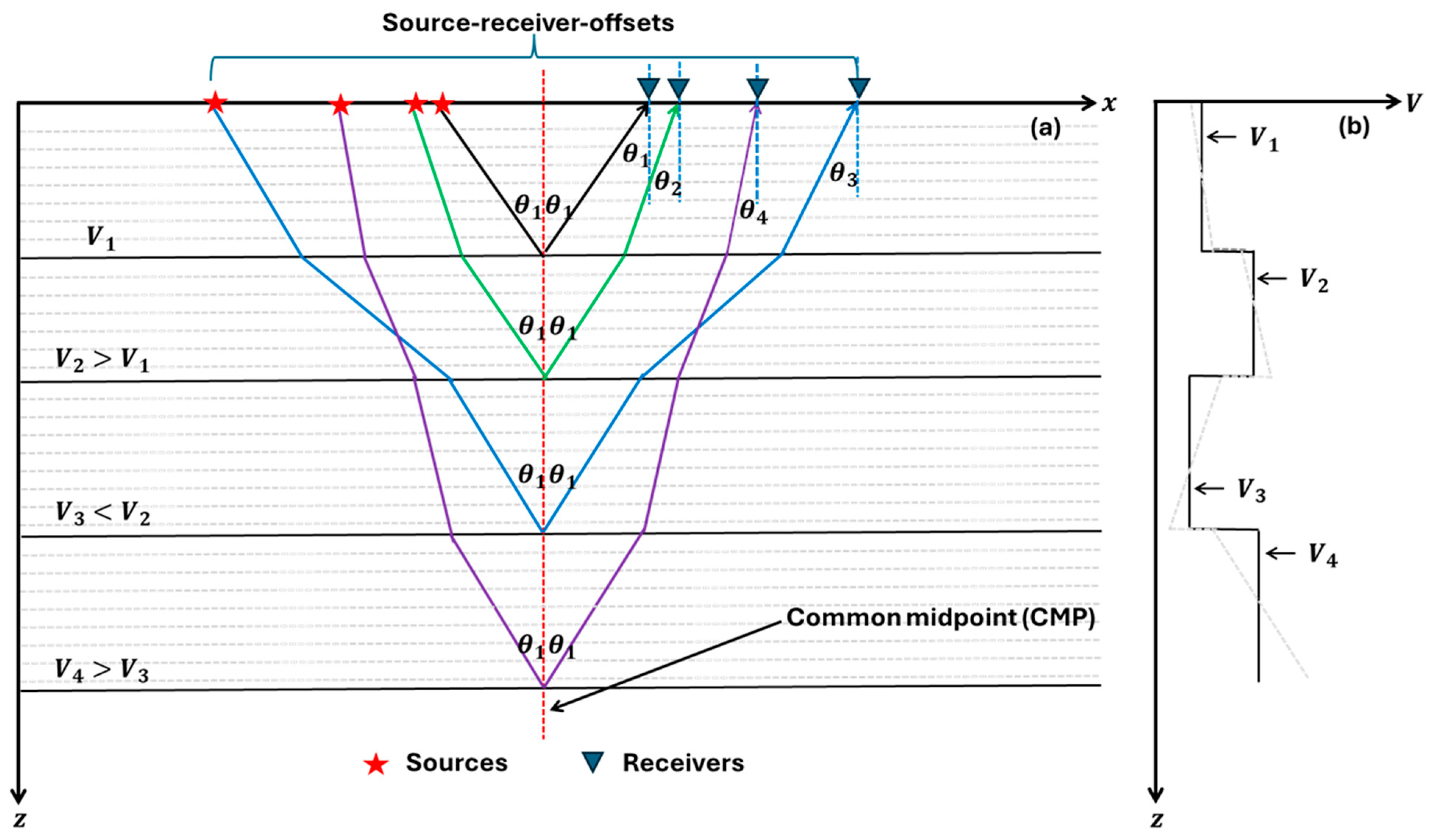
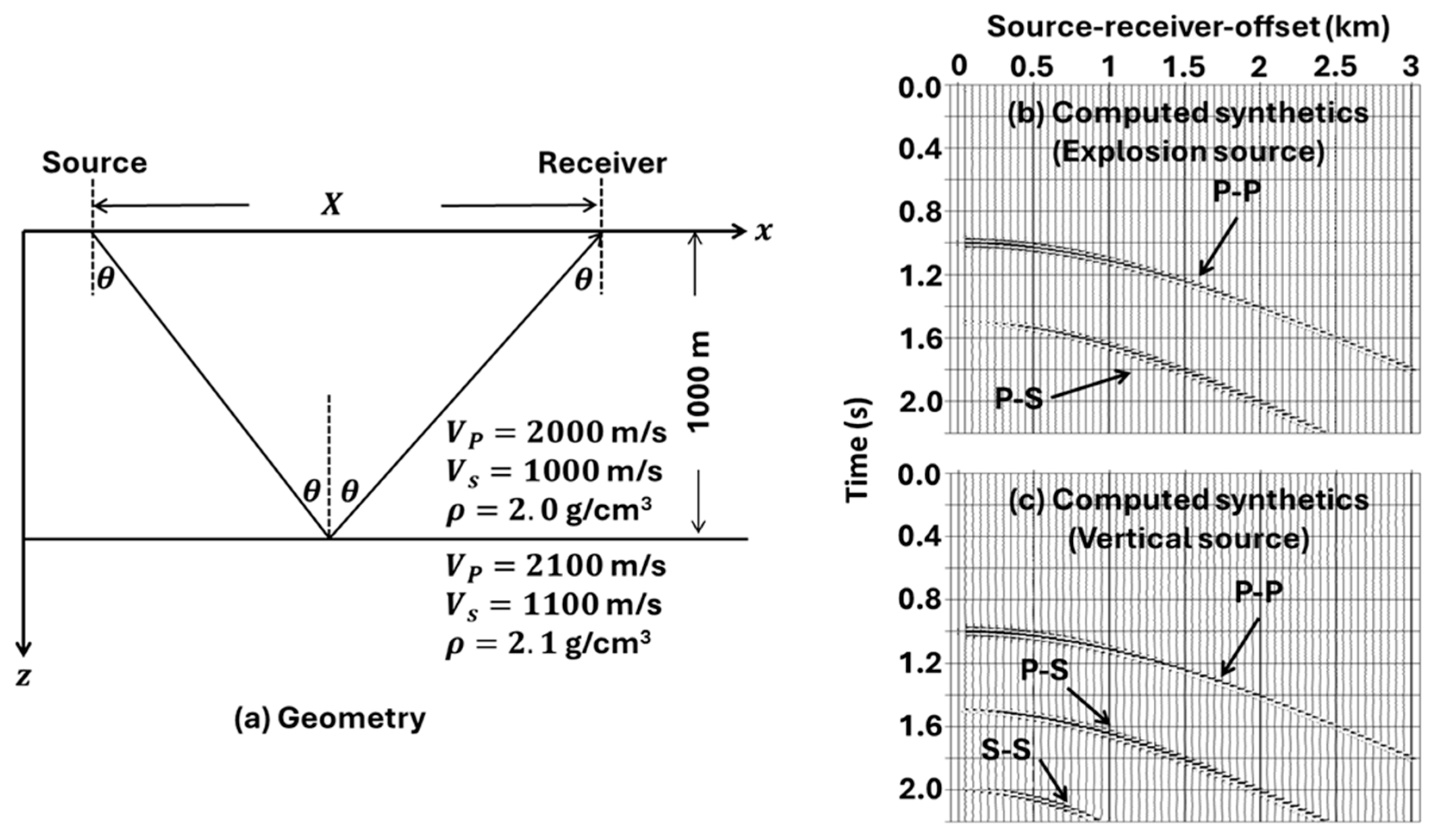
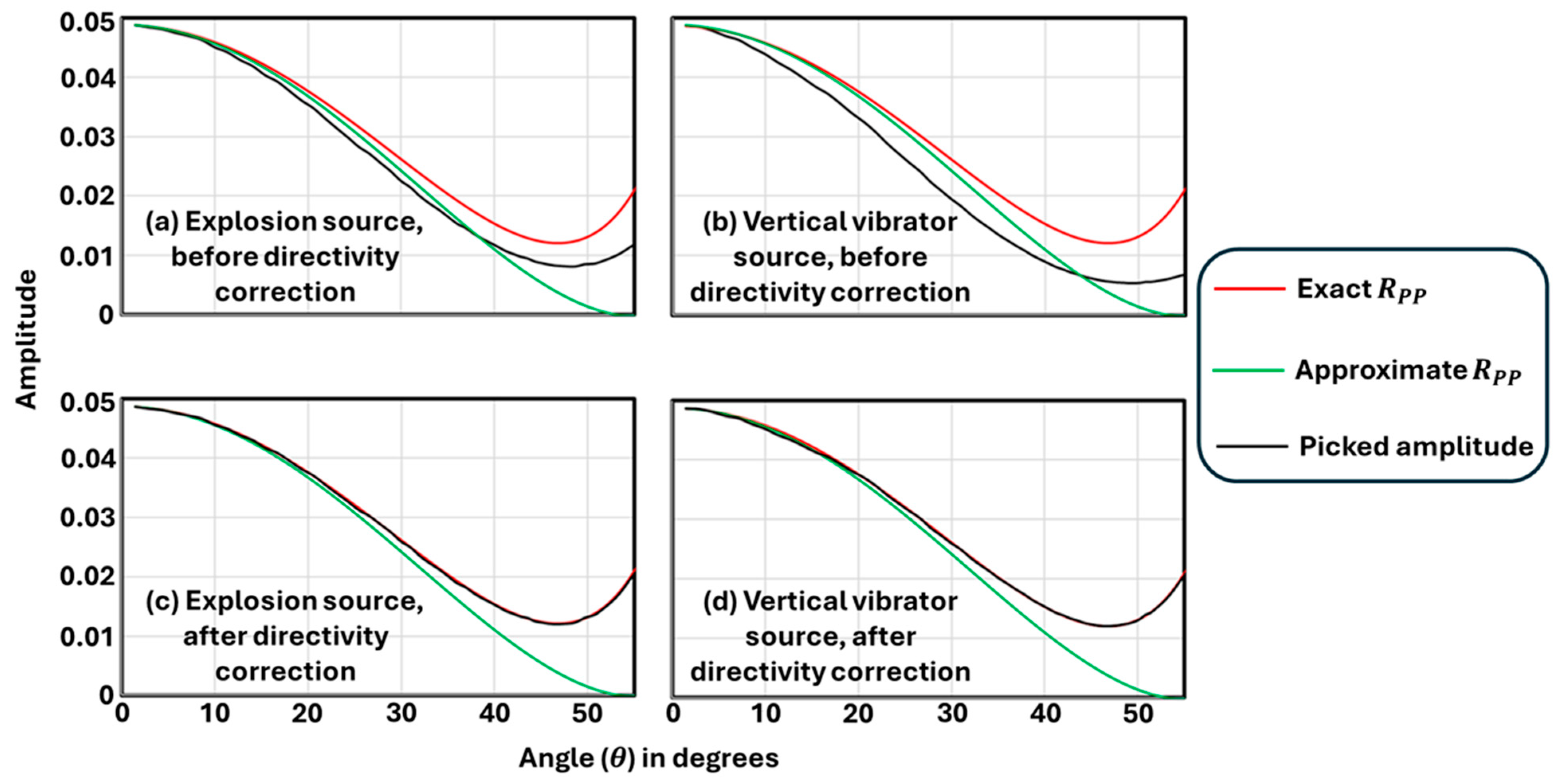

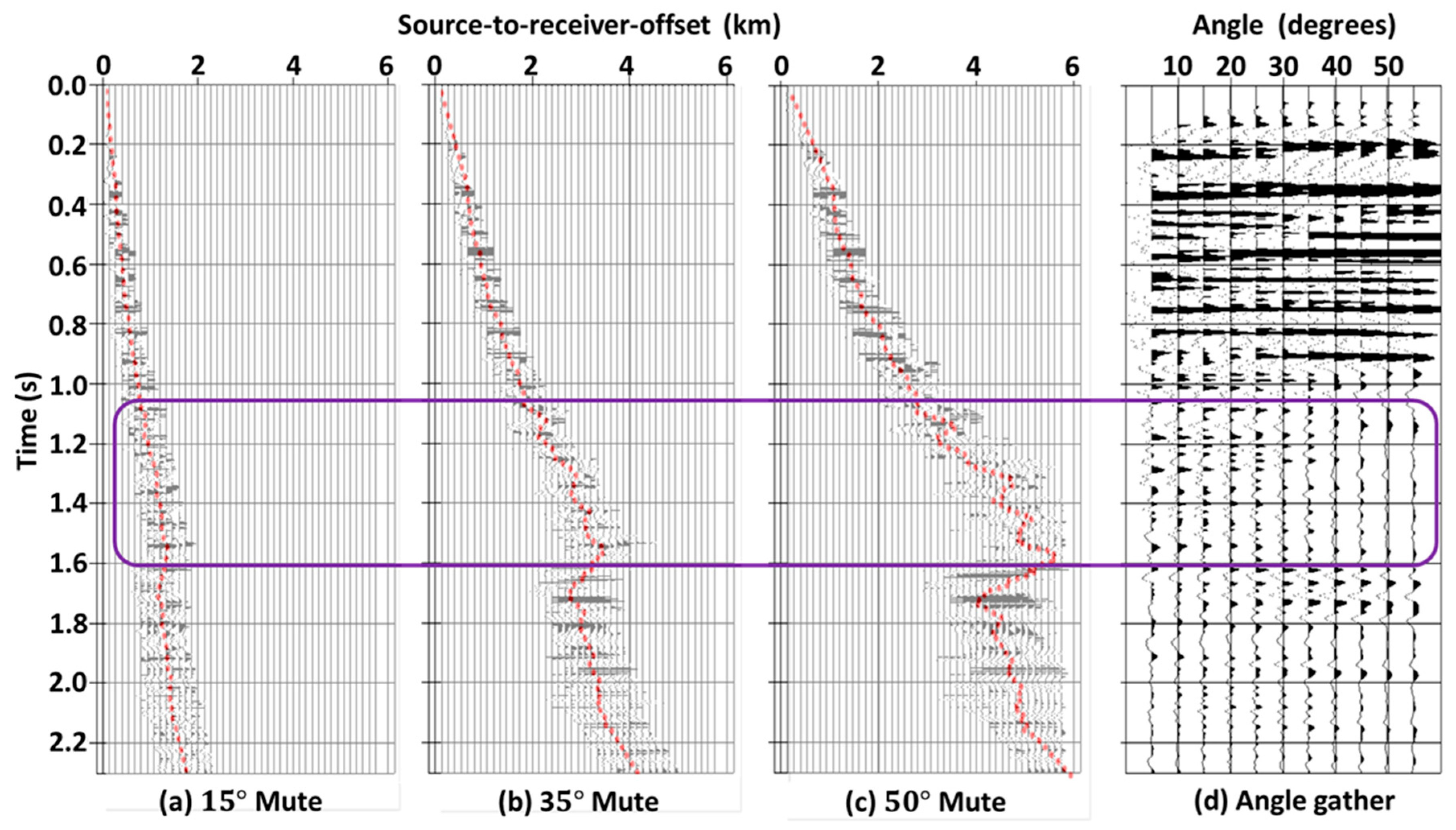


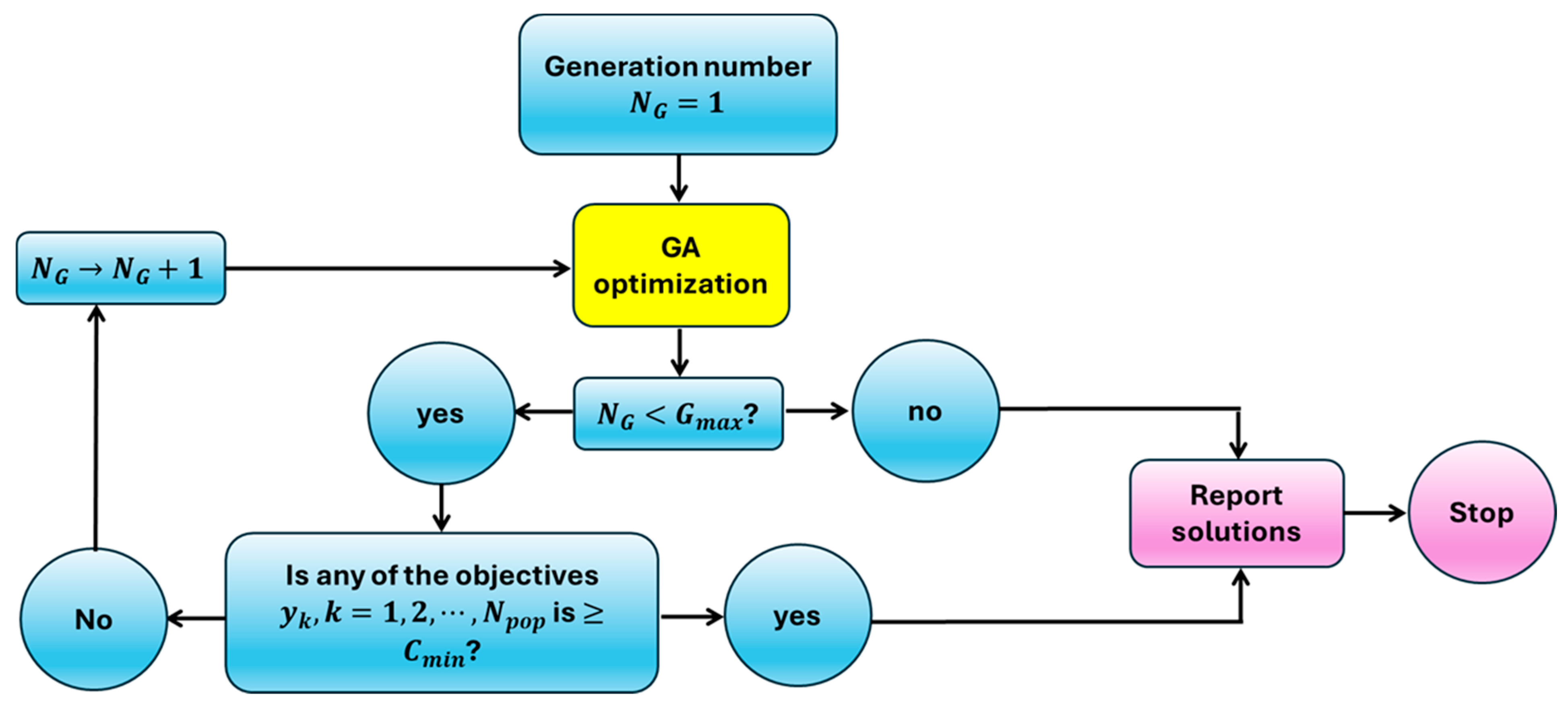
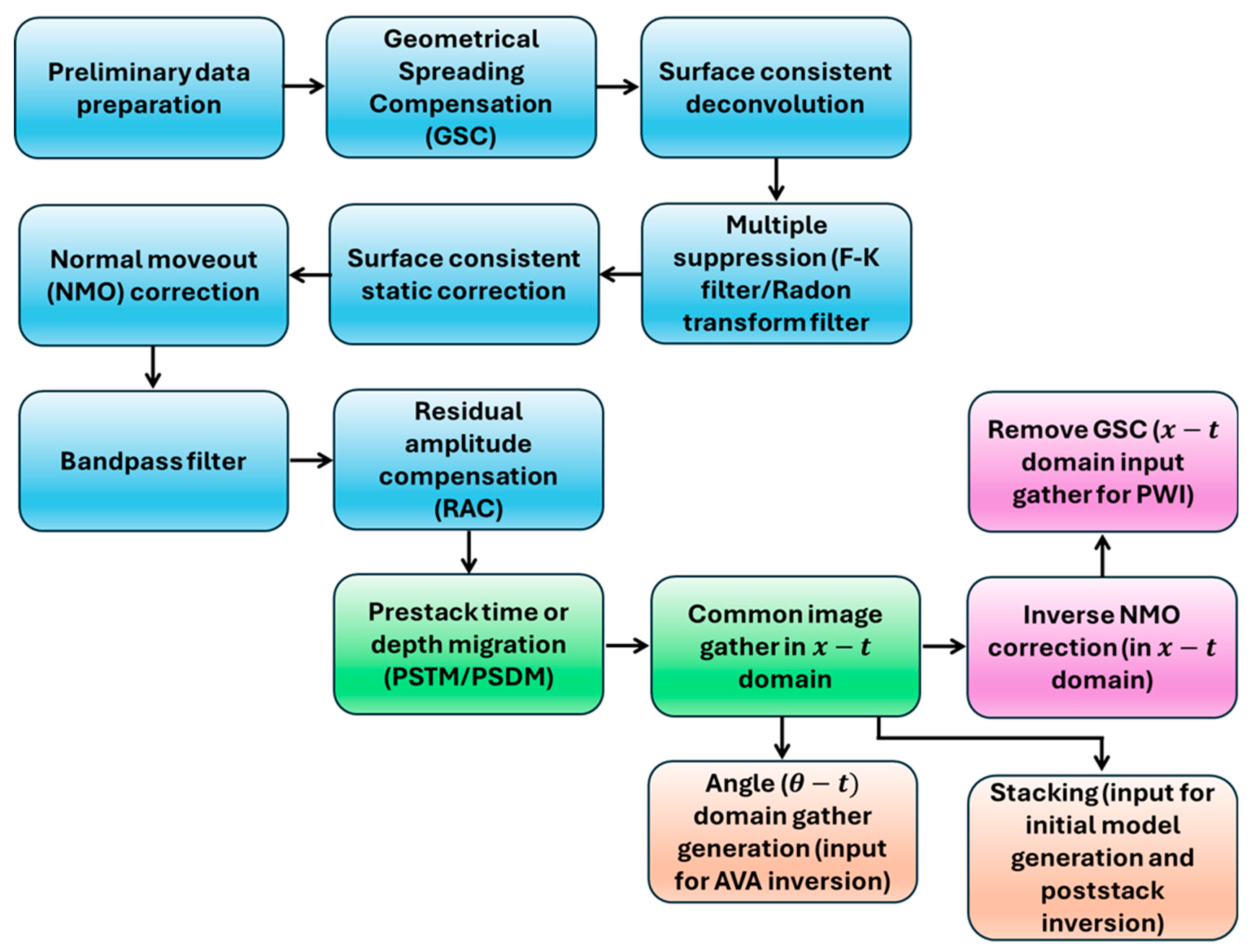
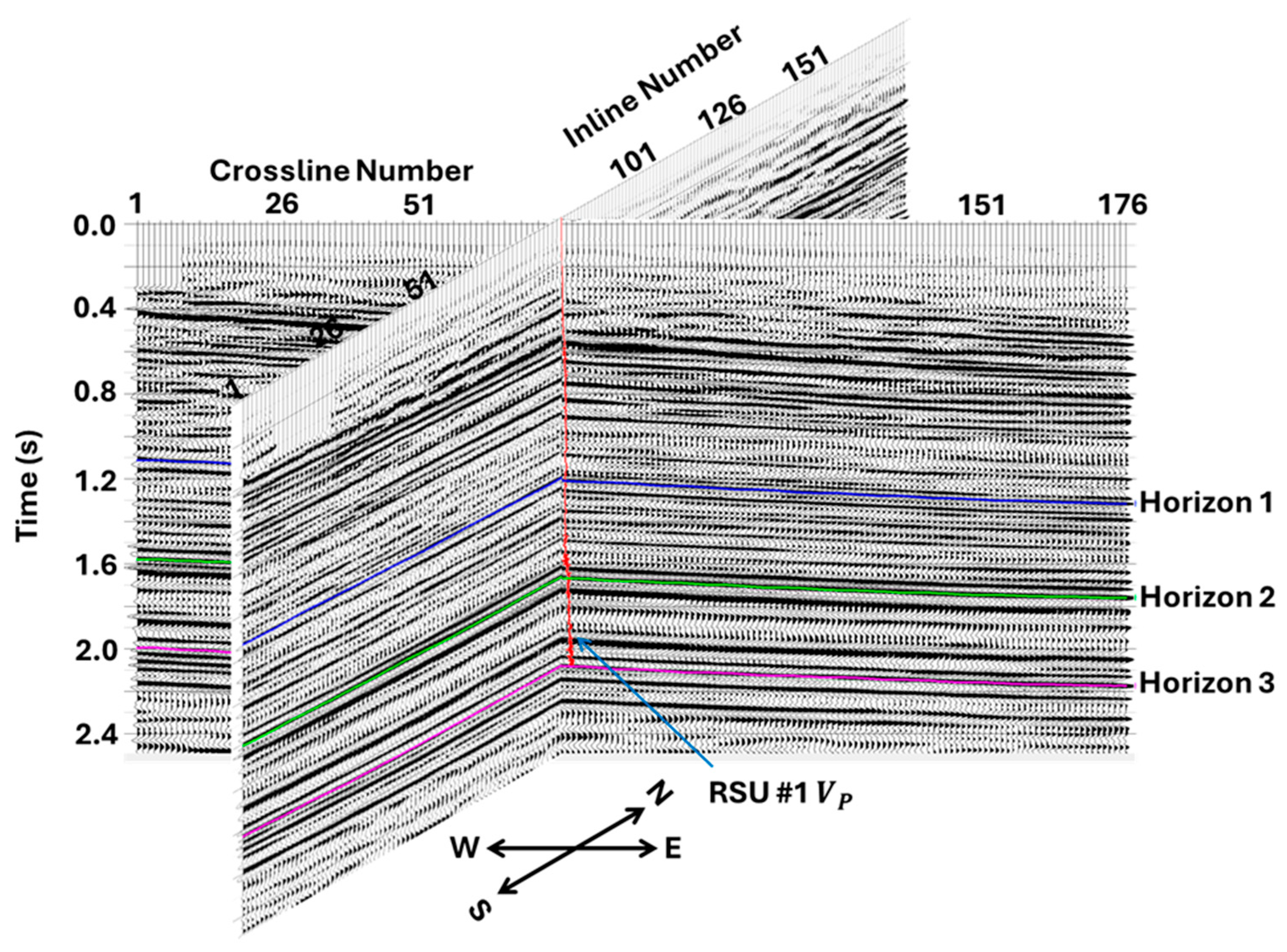
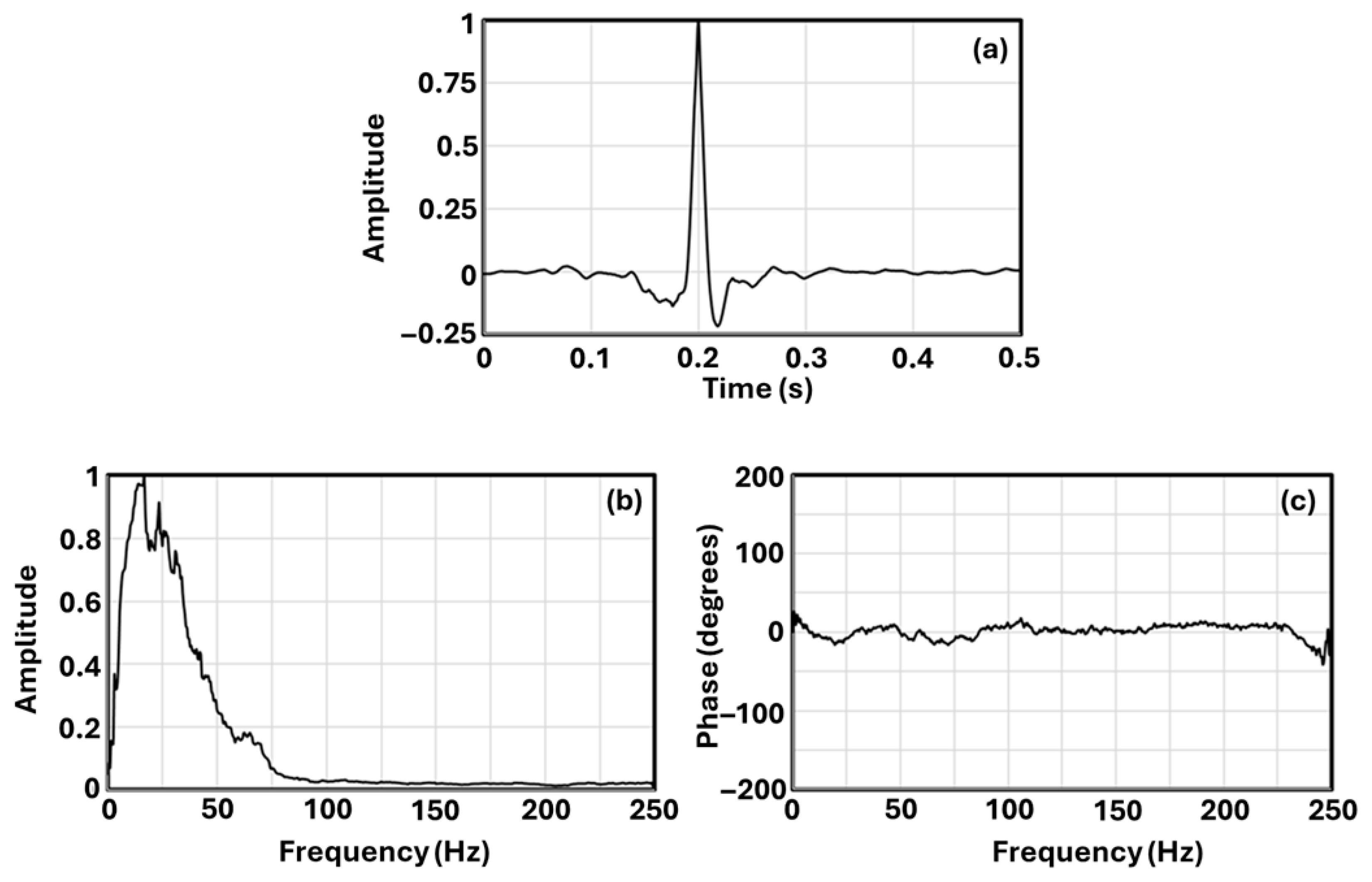
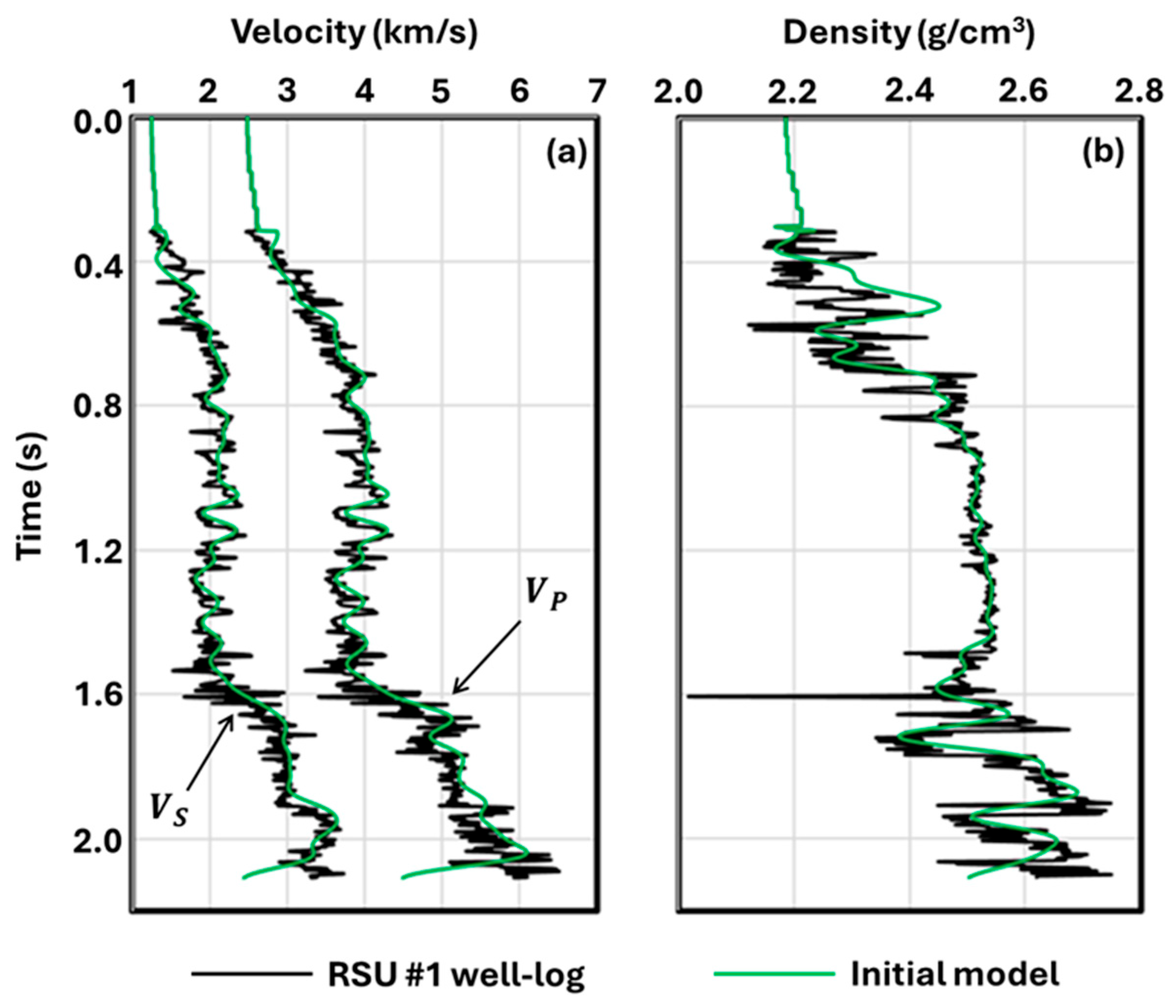





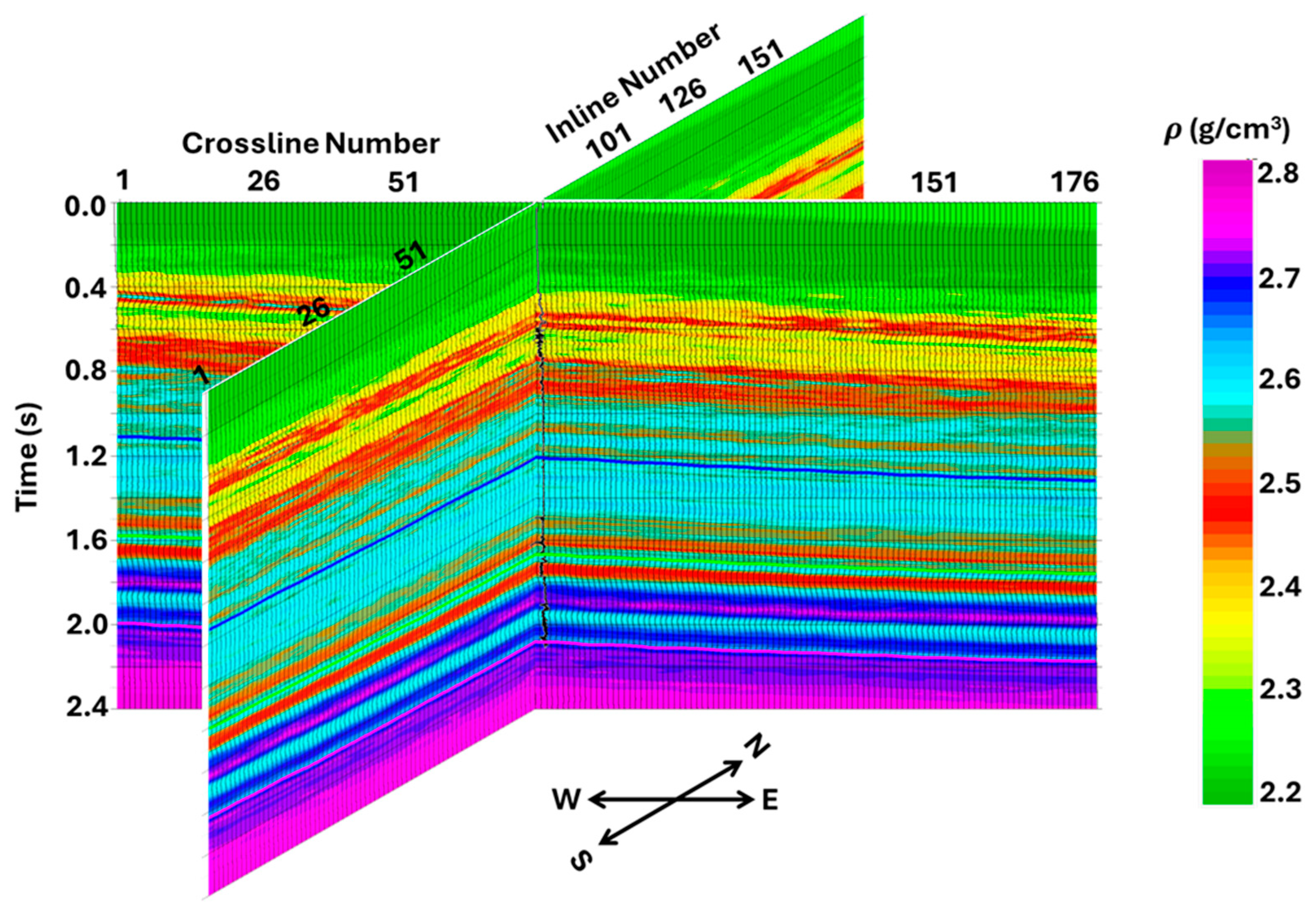

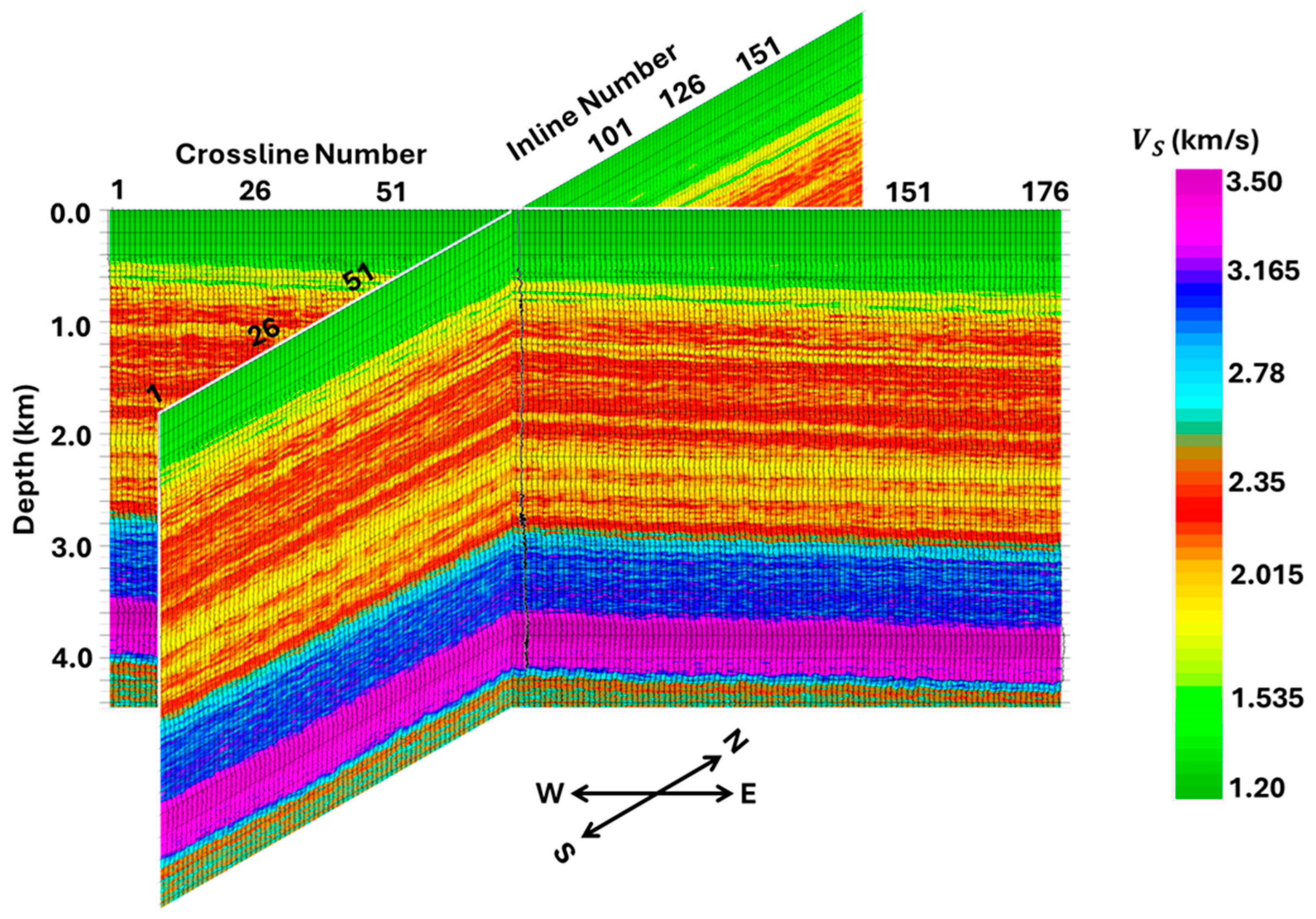
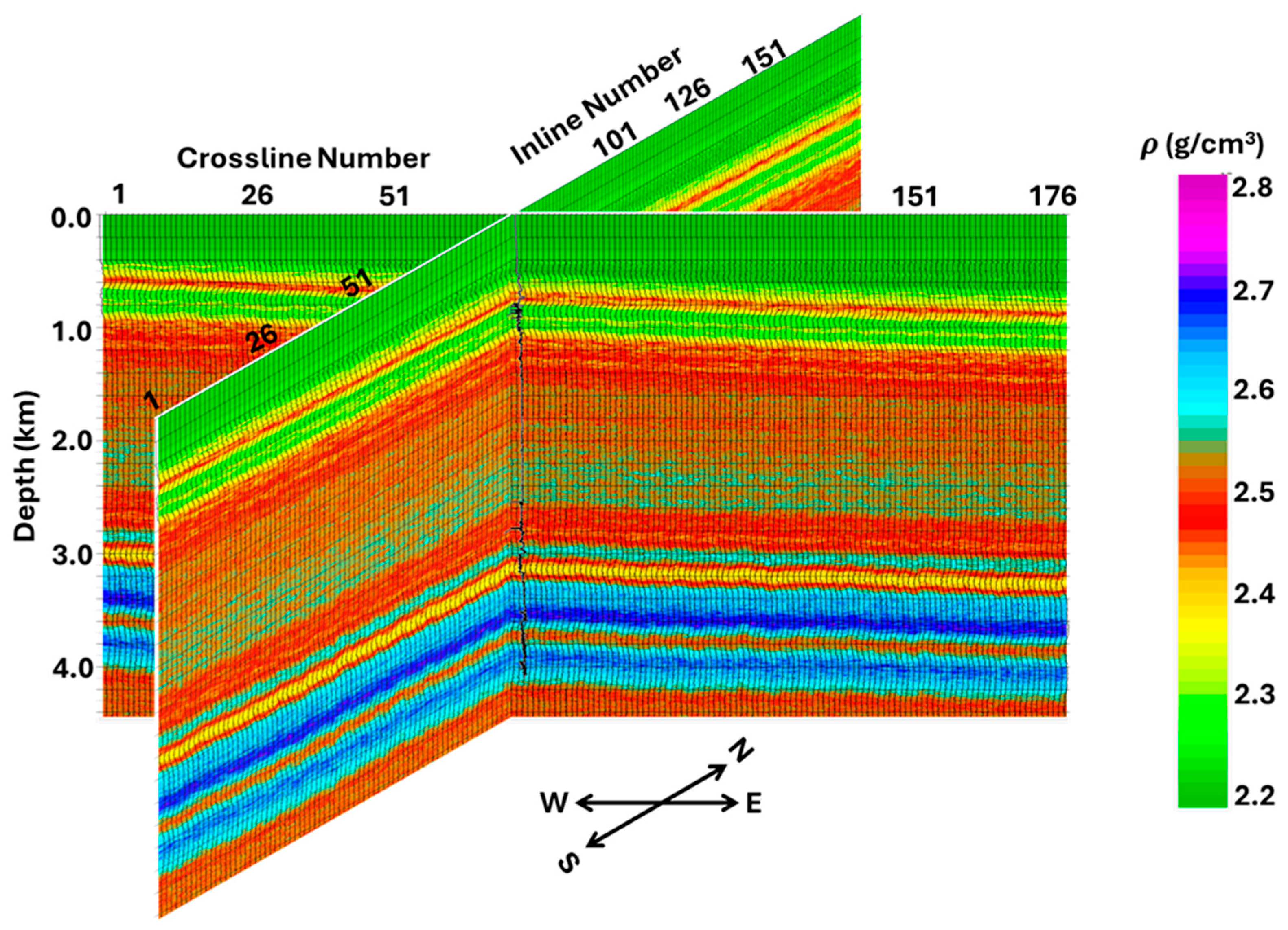

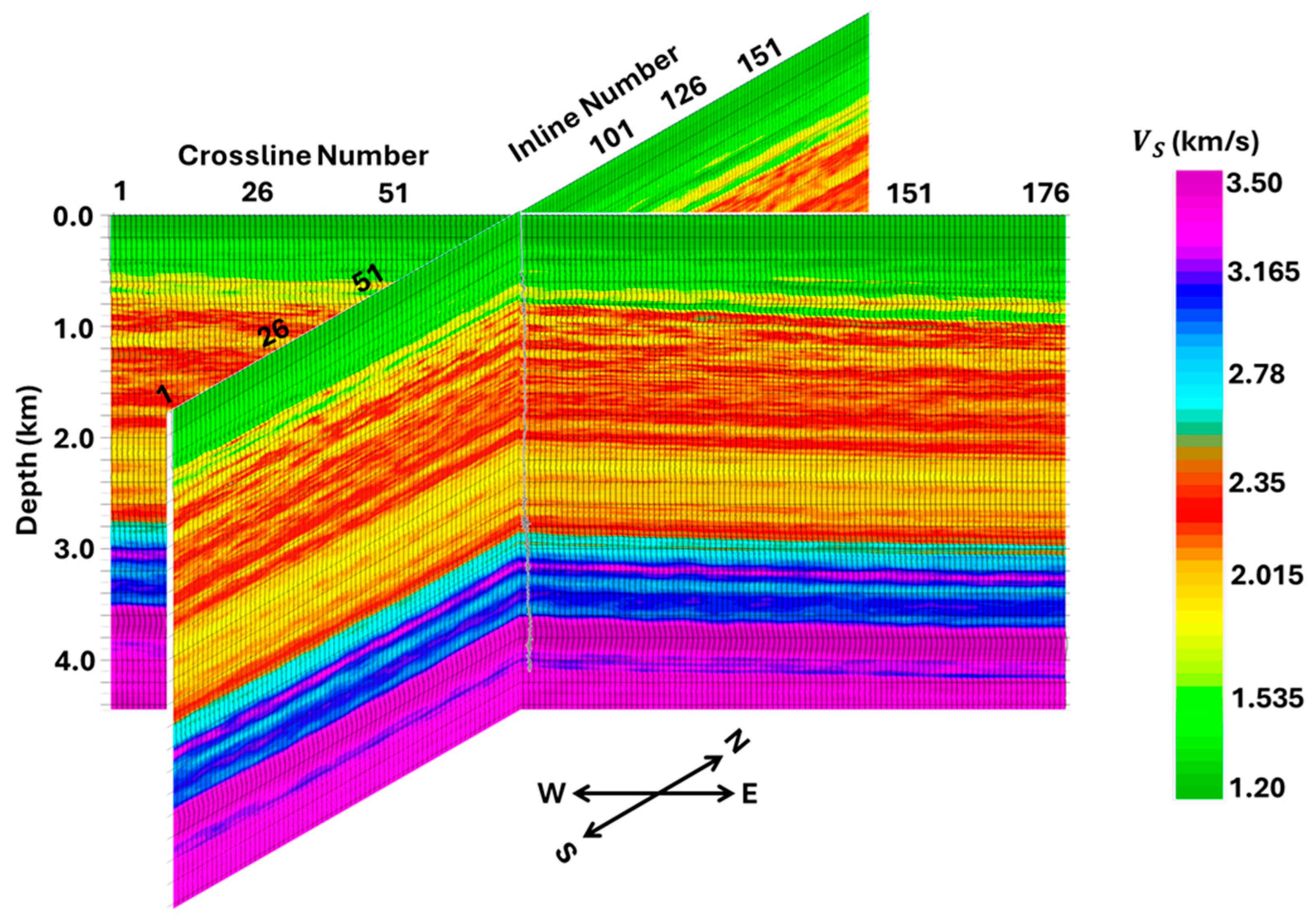

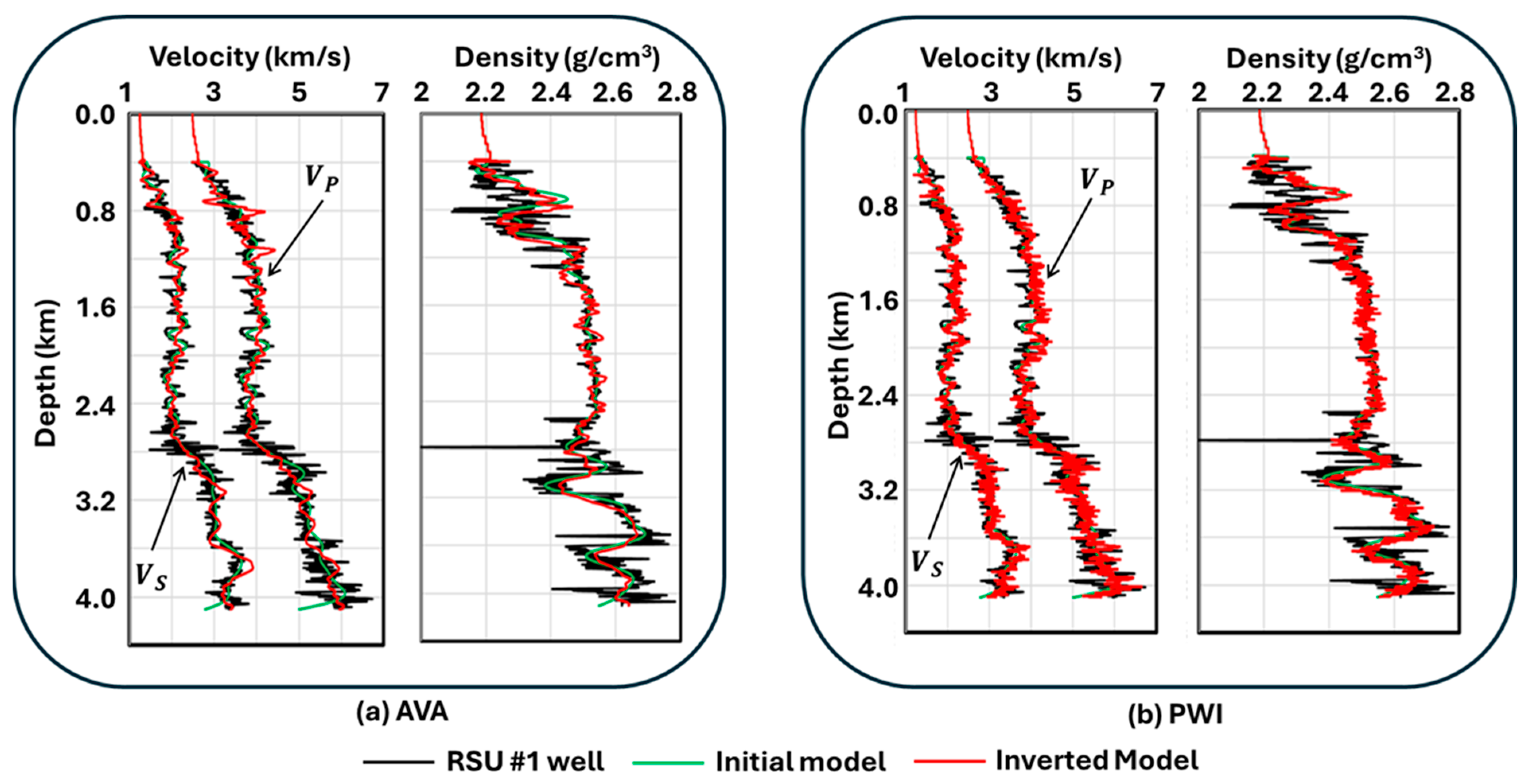


Disclaimer/Publisher’s Note: The statements, opinions and data contained in all publications are solely those of the individual author(s) and contributor(s) and not of MDPI and/or the editor(s). MDPI and/or the editor(s) disclaim responsibility for any injury to people or property resulting from any ideas, methods, instructions or products referred to in the content. |
© 2025 by the authors. Licensee MDPI, Basel, Switzerland. This article is an open access article distributed under the terms and conditions of the Creative Commons Attribution (CC BY) license (https://creativecommons.org/licenses/by/4.0/).
Share and Cite
Mallick, S.; Srivastava, A.; Chakraborty, D. High-Resolution Subsurface Characterization Using Seismic Inversion—Methodology and Examples. Eng 2025, 6, 206. https://doi.org/10.3390/eng6090206
Mallick S, Srivastava A, Chakraborty D. High-Resolution Subsurface Characterization Using Seismic Inversion—Methodology and Examples. Eng. 2025; 6(9):206. https://doi.org/10.3390/eng6090206
Chicago/Turabian StyleMallick, Subhashis, Aditya Srivastava, and Dwaipayan Chakraborty. 2025. "High-Resolution Subsurface Characterization Using Seismic Inversion—Methodology and Examples" Eng 6, no. 9: 206. https://doi.org/10.3390/eng6090206
APA StyleMallick, S., Srivastava, A., & Chakraborty, D. (2025). High-Resolution Subsurface Characterization Using Seismic Inversion—Methodology and Examples. Eng, 6(9), 206. https://doi.org/10.3390/eng6090206





